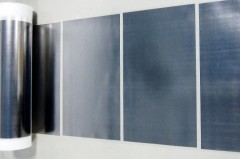Angstron Materials, a US supplier of single and few-layer graphene materials, announced this week that it has secured $5 million in capital to increase manufacturing capacity and bring key technologies such as its thermal management products to market. Heat spreaders developed by the firm can reduce hot-spots in mobile phones and other handheld devices, and the funding news follows reports earlier this year that Angstron’s graphene sheets have been qualified for use by a major mobile electronics company.

Thermal interface material: Angstron Materials supplies graphene-based sheets in thicknesses ranging from 5 µm to 40 µm with thermal conductivity between 800 W/m.K and 1700 W/m.K for use in electronic products such as tablets, laptops and flat screen TVs. The foils can also be used for EMI shielding.
Estimates by market analyst IDTechEx suggest that 55% of electronic failures are caused by over-heating, and enhanced thermal interface materials have a major role to play in helping devices to stay cool, perform better and last longer as developers boost their offerings by packing more processing power into increasingly compact form-factors.
“We use the planar alignment of carbon atoms to make a lightweight, flexible thermal foil with up to 1700 W/m.K in-plane thermal conductivity – substantially higher thermal conductivity than copper and offering weight savings for thermal management,” Claire Rutiser, a member of Angstron’s executive team, told TMR+. “Also, we can load thermally conductive nano graphene platelets (NGP) into a matrix – which could be thermoset, thermoplastic or non-curing (for thermal paste).”
Graphene isn’t the only option for device makers and competing thermal management materials include formulations based on silver flakes or silver nano-wires, but there are economic considerations that may favour the use of NGPs. “Silver is subject to significant price fluctuation and future price uncertainty,” Rutiser comments. “Angstron Materials has known input materials pricing and is able to enter into long term supply agreements with end users.”
Graphene has been linked with various big names in portable electronics. In 2011, Apple noted that the use of graphene thermal dissipators goes beyond cooling. Related applications include transferring heat from onboard electronics to the battery to improve runtime, which can be compromised at low temperatures.
Multiple markets
Rutiser says that Angstron is ready with scalable production capacity and emphasised that the firm is targeting other sectors in addition to thermal management materials. She’s optimistic that over a 10 year period energy storage will grow to become one of the company’s biggest sources of revenue. Driving this are developments in graphene-wrapped silicon anodes by sister company Nanotek Instruments, which allow fabrication of Li-ion batteries with over 400 Wh/kg, and also materials for supercapacitors.
“Affordable, high-capacity energy storage is critical for the transition to electric vehicles and for grid-stabilization as the percentage of energy derived from renewables increases in the coming decades,” Rutiser explained. “These products have comparatively long qualification times due to reliability testing and industry safety standards.”
Currently, Angstron’s graphene-enhanced products and technologies are linked to five distinct portfolios – thermal management materials, energy storage systems, nanocomposites, transparent conductive films, paints and coatings. “Graphene platelets are inert to most chemical species and offer opportunities to improve barrier coatings against corrosion, chemical attack, or oxygen permeation, “ added Rutiser.
Read next –
Thermal interface materials: opportunities and challenges for developers (Rachel Gordon, Translational Materials Research)
Show report: IDTechEx Printed Electronics Europe 2015 (TMR+)
Supercapacitors: market factors to consider (TMR+)
Fullerex talks graphene pricing; identifies growth areas and supply targets (TMR+)
Graphene ‘quilts’ cool down transistors (nanotechweb.org)

Pingback: Business school mines big data for clues on graphene commercialization | TMR+
Pingback: 4 Reasons to Invest in Graphene | Graphene Investors
Pingback: A hype-chart for next-gen batteries: mapping the translation of beyond lithium-ion chemistries from lab to market | TMR+